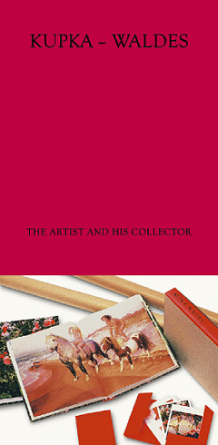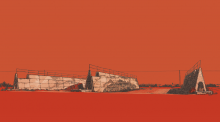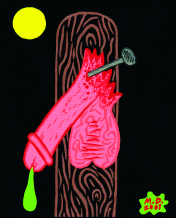| Zeitschrift Umělec 2002/2 >> Super Stage | Übersicht aller Ausgaben | ||||||||||||
|
|||||||||||||
Super StageZeitschrift Umělec 2002/201.02.2002 Michaela Ivaniškinová | exhibition | en cs |
|||||||||||||
|
"In the mid-1980s Bob Geldof came up with an ingenious way to help the starving people of third world nations. On his initiative the top rock stars in England locked themselves in a studio where they recorded a best-selling single while giving up the right to claim any artists’ fees. Five and a half million fans bought the record, bringing in a profit that topped eight million dollars.
“All I’m doing is turning famine into a hip thing,” declared Geldof. Who would have thought that a rocker could be prophetic? Immediately afterwards a rash of megalomaniac projects, gala concerts and television charity programs broke out. Charity became entertainment and lost the harsh taste of self-denial endowed by the ascetics of the 19th century. If we are to believe the theory of the popular French philosopher Gilles Lipovetsky — and I don’t know why we shouldn’t — then human society has crossed the threshold of the post-moralistic era. Of course this does not mean that it is now amoral. Like most of us, Dutch artist Saskia Janssen neglected to notice when exactly it was that we left behind the moralistic and passed into the post-moralistic age. After all, it’s quite possible that even the divine Geldof missed this moment of change. Nevertheless Janssen’s biography provides enough clues for us to draw a conclusion. The pivotal moment came in 1989 when Saskia, just twenty-one years old, entered the circus. She bumped around Europe for a year in a trailer and night after night performed as a snake charmer. Surprisingly, however, Saskia doesn’t look back on her days in the circus with fondness. She had no roots in the circus, so this closed community of “profane” people refused to really accept her among them. This was why Saskia decided to abandon the nomadic life and sign up for art school. First she spent five years in the Royal Academy of Fine Art in The Hague and another two years at the renowned Rijks-akademie in Amsterdam. She picked up a camera for the first time while in school and arranged her first models. Her first scenes starred her friends and acquaintances, and she didn’t hesitate to stop random passers-by in the street. The script has remained basically unchanged: Saskia ingeniously sets up a scene and then asks participants to behave normally in abnormal situations. At first sight her works look like sociological documents, and Saskia does not deny her interest in sociology. But that doesn’t mean that she intends to give up the esthetic side of the work. Every shot carries within it elements from the compositions of images that her friend George Korsmit paints and the two artists have realized a number of projects together over the past few years. Describing the artistic signature of Saskia Janssen is quite difficult. Standing face to face with her work can make you feel slightly schizophrenic — that what you see is what you see, yet at the same time there’s something odd happening there. The documented actions all seem to ring a distant bell, but you cannot recall from where or what or why. And what’s worse, the tempo of the stories crawls along at a turtle’s pace, but you never get bored. Why? While it is true that Saskia once made a living as a magician, it is probably not the right explanation. Since her first attempts at making art she has consistently tried to cross the limits of established ideas. With absolute calm she mixes performance with acted documentary, photographic portraits and even sculpture, and the resulting cocktail then draws the unaware audience forward. The last time this happened was in June of this year at Gallery Display in Prague under the curatorial direction of Radek Váňa. The projects exhibited here showed formal and content consistency, which is generally true of all her recent work. Janssen’s method of presentation also attests to this. Video projections, sometimes complemented with music, are accompanied by a static slide show documenting the process of the individual event/performance. One of the Janssen’s first large-scale projects was made in 1997. Together with George Korsmit, Owen Oppenheimer and a disparate group of Dutch office clerks and Indonesian businessmen she sailed on a ship from Hong Kong to Shanghai. The several-day journey gave rise to an amazing amount of documentation, including piles of photos and video recordings, as well as eight letters in a bottle. Janssen calls it Double Happiness, referring to what took place onboard. The photographs show successful Indonesian businessmen levitating about a meter above the floor. They hover there with their arms spread out like birds and all of them are smiling. This illusion of unearthly phenomenon, however, is disturbed by the construction of iron tubes that supports businessmen. Here Janssen was inspired by an event that happened over one hundred years ago — a performance for the German season in the Metropolitan Opera in the spring of 1897. With the assistance of an ingenious but rudimentary contraption, the “Daughters of the Rhine” flew over the stage directly in front of the wonder-struck onlookers. The piece has long been removed of the theater repertoire, but Janssen saw it as an engraving in a book on theater. Similarly, she is interested in the English word “float” with its many meanings, which, among others, includes levitating and suspension in water, as well as stock market operations. She has the ability to leap with the finesse of a circus performer from one semantic level to another. Her effort to conceive individual stories as grand spectacle using low-cost means hints back to her circus days. The Dutch artist has used simple instruments to create illusion in other projects as well. In March 2000, she was entrusted to lead a two-day workshop for students from the Academie des Beaux Arts in Rouen and make a work of art with the young artists. But it occurred to Janssen that she could use the actual students themselves as her material — make a work not only with them, but also out of them. Using metal arm and leg pegs capable of fastening to any surface at any height, she suspended her students from the classroom wall, where they would normally hang their artwork. Janssen later used these pegs in Drewen, a godforsaken village in former East Germany. She met nine children that were staying there through the holidays, and they hung out for a while together at a bus stop. During the summer months Drewen offers almost no opportunity for entertainment. The local club is closed and the only fun to be had for the kids is an old beat up motorcycle. Even so, when the Dutch artist explained what she wanted them to do, they turned extremely disdainful. Not a surprise; the news of contemporary art has not yet reached Drewen. Soon, however, initial distrust passed and the Drewenians allowed themselves to be sucked into the game, and they even began to enjoy it. The rules were relatively simple: a few meters from the bus stop stood a wood barn, whose walls served as a backdrop for a peculiar group portrait. In the kids’ expressions you can read genuine satisfaction from the work. One of the local boys, Riko, even came up with the title: Unterbrechung Drewen (Breaking Boredom in Drewen). Mentioning group portraits often calls to mind the name Gillian Wearing. And it is true that Janssen’s work shows some similar traits with that of the British artist. Both balance on the border between sociological inquiry and art, but the final results of their work ultimately differ. The differences emerge in particular when comparing the ways in which both artists work with time. In her group portraits Gillian Wearing draws its energy from surprising connections between static shots and dynamic elements of video. For example the film 60 min., Silence initially looks like a photograph of a police force, and we only discover that it is a video recording the moment that the forced discomfort of the officers comes to the surface as they begin to waver or cough. On the other hand Saskia Jannsen takes advantage of the possibilities that editing offers, so that the desired effect rarely goes beyond 15 minutes. But above all she allows her participants near total freedom during shooting. When watching a number of her films an unusual phenomenon occurs, which may be expressed with a simple mathematical equation: The amount of fun the watched are having is equal to the amount of fun the watching have. It’s necessary to emphasize here that Janssen never chooses her actors at random. Her characters always consist of a homogenous group of people, even when she calls on people in the street to participate. The actors in the video Scene Shifters meet for the first time in front of the camera, but they still have something in common. They are immigrants, refugees or children adopted into a new family, essentially people removed from their original environment. Janssen has them strike odd poses in foreign environments, on a revolving stage, as she creates an effective metaphor for their life destinies. Janssen is also working with immigrants in her latest project, which will take place in botanical gardens in Amsterdam. This group of five immigrants lives in Holland illegally. One of the paradoxes of human history is the fact that the plants in this celebrated botanical garden were grown from seeds stolen from the very countries these people originally came from. The artists Janssen and Korsmit are planning to shoot in the autumn. Something tells me that in this art race, the rabbit of history will not necessarily defeat the turtle of art. "
01.02.2002
Empfohlene Artikel
|
|||||||||||||
|
04.02.2020 10:17
Letošní 50. ročník Art Basel přilákal celkem 93 000 návštěvníků a sběratelů z 80 zemí světa. 290 prémiových galerií představilo umělecká díla od počátku 20. století až po současnost. Hlavní sektor přehlídky, tradičně v prvním patře výstavního prostoru, představil 232 předních galerií z celého světa nabízející umění nejvyšší kvality. Veletrh ukázal vzestupný trend prodeje prostřednictvím galerií jak soukromým sbírkám, tak i institucím. Kromě hlavního veletrhu stály za návštěvu i ty přidružené: Volta, Liste a Photo Basel, k tomu doprovodné programy a výstavy v místních institucích, které kvalitou daleko přesahují hranice města tj. Kunsthalle Basel, Kunstmuseum, Tinguely muzeum nebo Fondation Beyeler.
|

































 We Are Rising National Gallery For You! Go to Kyjov by Krásná Lípa no.37.
We Are Rising National Gallery For You! Go to Kyjov by Krásná Lípa no.37.
Kommentar
Der Artikel ist bisher nicht kommentiert wordenNeuen Kommentar einfügen